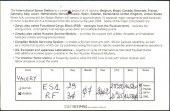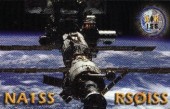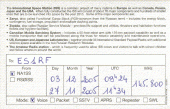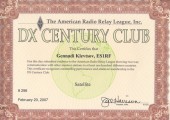 In my log I keep around 4100 QSOs from 119 DXCC countries via satellites.
In my log I keep around 4100 QSOs from 119 DXCC countries via satellites.
And hold the DXCC Award Satellite # 296.
This a very interesting and specific subject of HAM activity. In the past years I was very active via satellites. But after crushing of all High Earth Orbit (HEO) satellites (AO-13, AO-40) I practically stopped satellite operation and only periodically checking the satellites segment of bands, just to find new callsigns. And using very simple setup: FT-847 and dual-band vertical Diamond X-400 antenna.
Practically, all satellites has name OSСAR with a serial number. OSCAR means abbreviation from Orbiting Satellite Carrying Amateur Radio) such as AO-7, AO-10, AO-13, AO-27, AO-40, AO-51….
The oldest, but still alive satellite, has name OSCAR-7 (AO-7). It has been launched on November 15, 1974, nearly 40 years ago. The largest, most modern and powerful satellite AO-40, after a catastrophic failure of the main battery, was died in January, 2004. Little bit more, than 4 years in the space… Very pity!
It was a lot of experiments with antennas and equipment, when I worked via satellites. Especially, when AO-40 was operational. Many bands, new antennas, different modes (even RTTY!). Lot of fun!! Below is my antennas setup for AO-40 (formed).
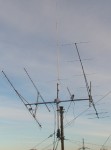 From the left to the right:
From the left to the right:
-19 el yagi for 70 cm band with LNA,
– 35 el. yagi for 23 cm band;
– dual band vertical X-400 Diamond for 145/435 bands;
– 21 turn helix with down converter (2401/145 Mhz) for “S” band;
– 9 el. yagi for 145 Mhz.
Later, I re placed the helix antenna to a 70 cm dish with a MKU 24TM OSCAR down converter (from DB6NT). The AO-40 have had a very powerful transmitters and sensitive receivers on all bands.
placed the helix antenna to a 70 cm dish with a MKU 24TM OSCAR down converter (from DB6NT). The AO-40 have had a very powerful transmitters and sensitive receivers on all bands.
Once upon a time I make an interesting experiment. I spent few hours to build a 21 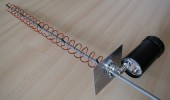 turns helix antenna, which was connected to a down converter (2401/145 Mhz) from Parabolic AB, Sweden. At the first evening new antenna was mounted inside the room
turns helix antenna, which was connected to a down converter (2401/145 Mhz) from Parabolic AB, Sweden. At the first evening new antenna was mounted inside the room
and I found AO-40 through the closed window. I was surprised to hear a main beacon with a 2 S-units over the noise level!
Then I found several stations from Europe, VK6XH and UN7PV. They all were loud enough!
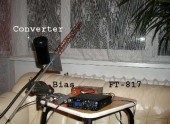 Range to the satellite was 62 000 km and squint 12.
Range to the satellite was 62 000 km and squint 12.
My station was in the other room, so I can not call to somebody, but I catch my own CW signal. All was perfect!
Many QSOs I made via FM satellites (UO-14, AO-27 and AO-51) , using a handheld dual band home made antenna, mounted on a wooden boom.
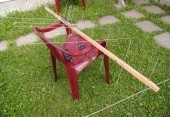
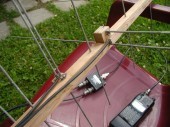
Amateur Radio on the board of International Space Station (ARISS-ZARYA)
I have a several QSO with a crew members of ZARYA. Some of themes are confirmed by a QSL-cards.
The cosmonauts and astronauts have no much free time to work in the air with radio amateurs. And most of themes are not skilled HAMs.
But, Bill McArthur, KC5ACR, Commander, Expedition 12 International Space Station, logged more than 1750 contacts and received honorary Worked All States, Worked All Continents and DX Century Club awards from the ARRL on 2 meters for NA1SS.
27-th of November, 2005 I did made very easy QSO with him too. And I was more surprised to get from PA0RKC (Cor) audio file. He recorded part of our QSO, of course only what he can hear, i.e. NA1SS, who was calling me on 145.200MHz (downlink QRG). 27112005_ES1RF_NA1SS
Now my satellite activity, practically, stopped. No interest any more…


